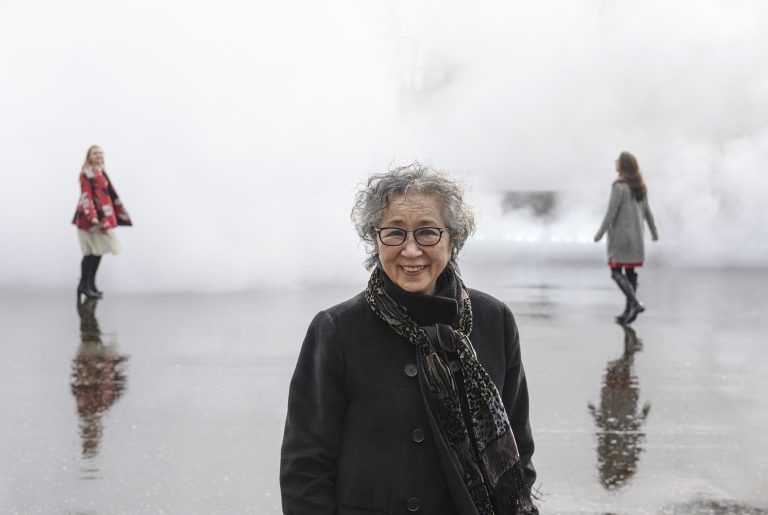THE SCULPTURE

Over 100 people are standing in a large, rectangular, exhibition hall. Tall white walls lead up to a large skylight in the roof, which lets through blotchy hues of blue and turquoise. Wood-framed doorways lead into dark side-rooms. The hall is also flooded. To avoid stepping in water people make their way along an angular wooden gangway that lines the walls and meets in the centre of the room, where it forms a small wooden island. In the middle of this island are two rectangular frames—one taller than the other—which hold up stainless steel tubes, a row of nozzles jutting up from both of them. More tubes can be seen lining the gangway, hidden underneath the planks, just above the water.
Suddenly, a deafening hiss. Somewhere, a motor powers a pump that accelerates a mass of purified water through the tubes. At a pressure of over 1,000 pounds per square inch (about ten times the pressure of a regular foot pump), the water is forced through nozzles with a 0.15 mm aperture. A thin needle tip in the aperture splits the stream into droplets of 17-microns in diameter (about twice the length of a red blood cell). But as soon as they explode into the air, freedom. Wisps of droplets come together to form a thick white fog in the centre of the room. It curls and flows, rises and falls, traversing the space with a serenity that belies the violence from which it was birthed. As the fog moves it encounters things: people, walls, doorways. It drifts past surfaces, curls around obstacles, and immerses human bodies. The visitors are engulfed by the mist and welcome it, wafting their hands around, feeling the water on their skin. Those who stand in it for long enough emerge with beads of moisture clinging to their hair. The cloud slowly makes its way towards the room’s far exit, getting fainter as it goes.
The hissing has stopped now. Slowly the room becomes fully visible again: bare white walls, angular wooden gangways, rows of stainless steel tubes. It seems as if nothing has changed. But as the spectators saunter into the adjoining rooms, they murmur excitedly. For a precious few minutes they were embraced by a man-made fog. Some may have marvelled at the sight of a cloud indoors, others at the engineering prowess behind it. Whatever the response, the industrial-looking array of tubes and nozzles helped create a fleeting experience of wonder for the spectator: an artwork built on decades of scientific and technical knowledge, which uses fog as its medium.
The Artist
The installation is called Munich Fog (Wave), #10865/I (2022), and was designed by the Japanese artist Fujiko Nakaya. Born in Sapporo in 1933, she began her formal artistic training in the United States and Europe during the 1950s. Early on in her career she studied compositions of organic objects and processes, such as cell divisions, plant roots, and metabolism. During the mid-1960s she came into contact with a group of ecologically minded artists and engineers based in New York, who would later become known as the semi-anarchic collective Experiments in Art and Technology (E.A.T.). Nakaya quickly became a core member of the collective, and would play a prominent role in one of E.A.T.’s most important projects: the Pepsi Pavilion, created for the Japan World Exposition in Osaka, 1970.
Called on by her E.A.T. colleague Billy Klüver to drape the Pavilion in artificial fog, she spent a year carrying out research and development. She studied possibilities using chemical fog, steam, and dry ice, but wanting visitors to have a multisensory experience, she quickly eliminated those options, instead choosing water to allow for people to safely and enjoyably walk around in the fog. Her requisites for such a water-based system were: the ability to make objects invisible, and to make invisible things like wind visible; to feel soft and cool to the skin; and to interact with the atmosphere, so that when conditions changed it would disappear. Her research was carried out in collaboration with Thomas Mee, a cloud physicist and founder of Mee Industries, an engineering company in California. With a background developing fog-making technologies (with an eye towards agricultural applications), Mee and his company helped Nakaya design a system of 2,250 nozzles, which could spray over 40 tonnes of water per hour. The system worked so well that when it was turned on for the first time at only half capacity the resulting fog was so thick the Expo’s fire department rushed to the scene.
The Pepsi Pavilion installation arguably defined the rest of Nakaya’s career. While she produced numerous artworks in other media, including a number of experimental video works during the 1970s and 1980s, the hallmark of her artistic practice remained her fog sculptures. Many of her projects were carried out in collaboration with other artists, including dancers, musicians, videographers, and light artists, making them profoundly multifaceted experiences.
What does using fog as a medium actually mean?
Nakaya wants the experience of a fog sculpture to be a dialogue with nature and with oneself: “What it reveals to us is the relationship between artificial and natural, things and being, tangible and abstract, worldly and sublime, etc.” She explains that her motivation for creating fog sculptures comes not from the traditional objectification of nature as something beautiful, but from the desire to facilitate a relationship between a person and their environment, so that when someone interacts with a sculpture she has made, this interaction becomes part of how they relate to nature. This motivation is related to a core concept in the field of media ecology, namely that media themselves—not just their content—play an important role in affecting human responses, values, and understandings. The fog in Nakaya’s installations doesn’t expose a message—it is the message. She thereby hopes that people experience nature in an embodied way, gaining an “instinctive wisdom” to respect it (as opposed to just being told to do so).
Nakaya’s fog sculpture is both natural and artificial, or rather, it is neither one nor the other. Its wispiness and shapelessness hide a highly technical nature. Each installation is a machine made out of motors, pumps, tubing, valves, nozzles, and monitoring equipment, that is kept operational by technicians. This apparatus has remained largely the same for the past half century, yet before the first visitor ever touches a droplet, each unique sculpture goes through extensive research and development. Nakaya first gathers data on local humidity, wind speed, wind direction, and temperature. A study of the local topography is also important for figuring out how the fog would move. Armed with this knowledge, she carries out tests in simulated environments: previously in wind tunnels, and more recently using 3D software. These tests help her define the technological parameters of the installation: how many nozzles to include, what power the pump should be set at, and the on-off programming of the fog.
If we consider an artwork to be the product of an artist’s craftsmanship, who actually crafts the fog sculpture? Nakaya’s preparations are key in shaping how it will look and behave, but it is ultimately an interactive artefact: set in motion by plumbing, yes, but animated by visitors and the air. Observing a fog sculpture, one will find the occasional head or arm appear in the mist, before disappearing again. Human bodies raise the ambient temperature, increasing the rate of dissipation (Nakaya jokingly refers to them as “kilojoules”). Similarly, the fog constantly responds to meteorological and topographical conditions, with every change of wind, temperature, or pressure causing it to morph into a different shape. In a sense, it is not the artist doing the sculpting, but the wind itself. Recognising this, she has used the term “negative sculpture” to underline the way she relinquishes artistic control to the atmosphere. As the curator and art critic Anne-Marie Duguet notes: “she builds the experiential generator, and then lets nature do the rest.”
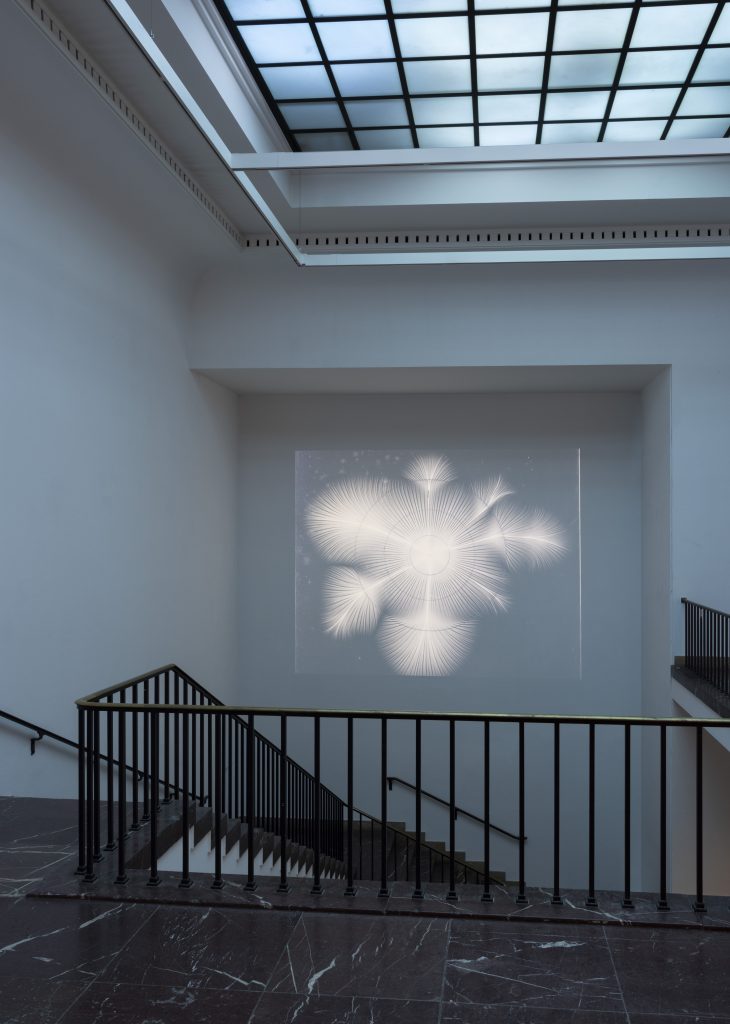
The Scientist
In pursuing her career as an artist Fujiko Nakaya has been deeply influenced by her father, the physicist Ukichiro Nakaya (1900-1962). In 1930, when he was appointed Professor of Physics in the newly established Faculty of Science at Hokkaido University, he had been given a limited set of resources to set up his research programme. Unable to study X-Rays as he had done in London the year before, he rather opportunistically turned to a poorly understood yet naturally abundant phenomenon: snow. Although he would later work on other kinds of atmospheric and glaciological phenomena (including fog), his studies into snow crystals made him one of the most important snow-crystal researchers of the 20th century, influencing not just the artistic career of his daughter but also a generation of Japanese cryo-scientists.
His research on the properties of snow crystals began in 1932. He spent the winter in a dormitory hut for forest guards on the slopes of Mount Tokachi in central Hokkaido, taking photographs with his students of a variety of crystals. His team continued this research for a number of years; yet despite collecting masses of data, they found that they were no nearer to answering the simplest and most fundamental question they had: why do snow crystals have such complicated structures? Realising that they needed to be able to observe a crystal grow from start to finish, Nakaya and his team developed a method of producing snow crystals artificially in the laboratory. When construction of the Low Temperature Laboratory at Hokkaido University was completed in February 1936, experiments could be carried out in the facility’s ‘cold chamber’, a room kept at about -35°C. This, alongside some technological improvements, meant the team could grow individual crystals, which they did on the tips of rabbit hairs. The success of this method was evident: within a decade, the team had produced every type of snowflake known to scientists at the time.
Snow crystals have captured the imagination of scientists for centuries. Though rarely studied systematically over long periods of time, records of observations have been left since the second century BC. Their ability to elicit wonder and amazement at the beauty of nature helped motivate numerous scientific studies. The snow-crystal photographs Nakaya and his team produced during the 1930s and 1940s were by no means the first collection of snow crystals—drawn or photographed—to be compiled, nor was it the largest. But at the time, their work was unique in replicating the natural phenomenon in a laboratory environment. Like his daughter’s fog sculptures, these snow crystals were created wholly by the operation of man-made apparatus, forming part of a particular scientific tradition called mimetic experimentation. This tradition involved attempts to “reproduce natural physical phenomena, with all their complexity, in the laboratory.” Despite being able to manipulate any feature of a snow crystal grown in the lab, Nakaya still revered these objects as marvels of the natural world. “Snowflakes are letters sent from heaven”, he famously stated. In producing snow crystals in the laboratory, he hoped to learn how to read them.
To continue supporting his assistants, students, and family during the war, Nakaya worked primarily on matters of interest of the Japanese military, such as atmospheric icing and methods for artificially dissipating fog (which his daughter would draw on decades later). But he continued his work on snow crystals nonetheless. Throughout his career, he also sought to reach wider audiences, becoming an active science communicator. He published over 40 books (not including his scientific publications) on various subjects, and produced a host of films with Iwanami Productions, a studio he co-founded in 1949. His first film, Snow Crystals (1939), offered viewers a glimpse into his scientific research, explaining how snowflakes grow and how to read their patterns. The film was followed by short, richly illustrated publications like Frost Flower (1945), which provided readers with an almost step-by-step account of his snow-crystal experiments. These outreach efforts were designed to inform and inspire the general public’s curiosity about nature; particularly those northern parts of the globe which when covered in snow and ice seem dead and desolate.
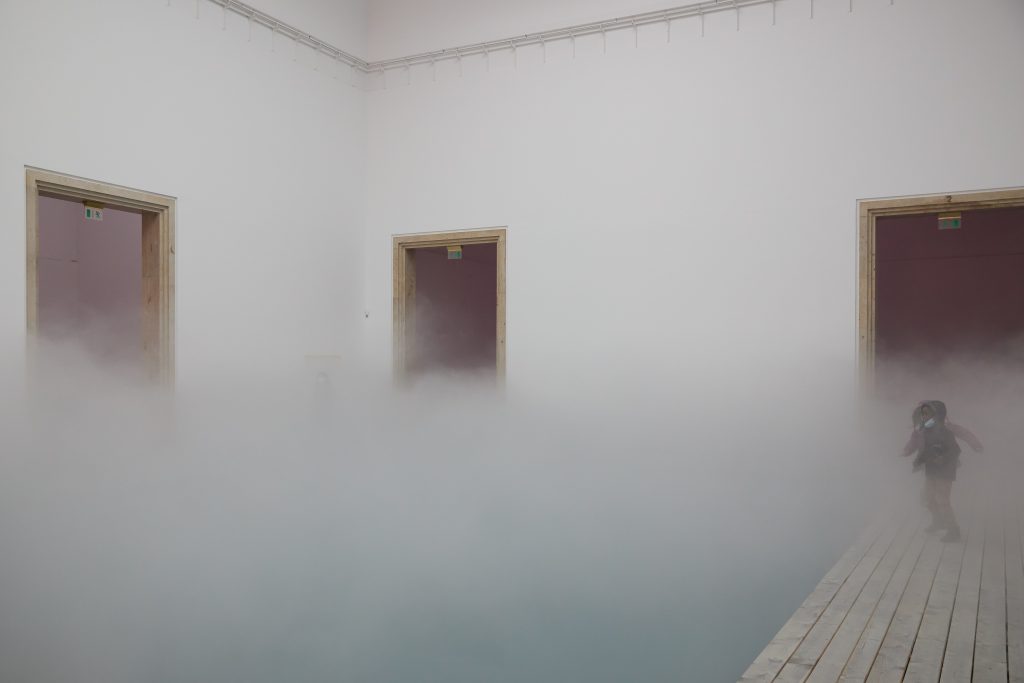
THE SCIENTIFIC DOMAIN
For many who have studied how snow crystals grow, the object represented something that tested their understanding of the atmosphere as well as their ability to probe it. Importantly, the study of snow crystals never occurred in a vacuum: it was always connected to other developments in science. In Ukichiro Nakaya’s case, his research programme of photographing snow crystals intersected with that of many others at the time. Wilson Bentley’s Snow Crystals (1931), cited by Nakaya as a source of inspiration, was the largest collection of snow crystal photographs published at the time, resulting from more than three decades of diligent observations on his farm in Jericho. In 1935, a year before the Low Temperature Lab was constructed, researchers in Davos had built their own snow laboratory to better understand the properties of snowpack and avalanches, also equipping it with a microscope and photo camera. In the following year, the English glaciologist Gerald Seligman’s influential Snow Structure and Ski Fields was published, which includes a description of the apparatus necessary for observing and photographing snow crystals. During the Second World War, when Nakaya was conducting studies for the military, researchers in Germany and the United States were also carrying out studies of snow crystals with military support. During the mid-20th century, many sets of eyes were on snow crystals, for many different reasons. It is no surprise that shortly after the war, international efforts were made to institutionalise this area of study—and Nakaya was at the heart of them.
Ironically, for phenomena that famously obscure vision, clouds and fog have a history of being used by scientists as a tool to observe things (or the consequences of things) that are otherwise invisible to the naked eye. For example, by 1900, the French physicist and photographer Étienne-Jules Marey had built one of the first aerodynamic wind tunnels, attaching it to a machine producing smoke from a row of nozzles (sound familiar?), enabling him to study how the smoke flowed around objects placed in the tunnel. A decade later, inspired by his experiences in the Scottish mountains, the physicist C.T.R. Wilson tried to recreate clouds in a laboratory environment. Using his ‘Cloud Chamber’, he inadvertently pictured the trails left behind by radioactive particles as they ionised the cloud droplets. Wilson’s artificial clouds sparked a frenzy of research in the physics community, as physicists scrambled to ‘see’ the new and existing particles. What started out as a man’s wonder at seeing clouds and fog in nature and his desire to recreate them eventually helped shape the fields of both particle physics and meteorology, underlining the boundary-crossing and -making potential of clouds and fog in science.
THE ARTISTIC DOMAIN
As we have seen, in the hands of an artist, clouds and fog can be a productive medium to work with. Already by the end of the 19th century, when electric light was becoming more widespread, people looked towards the clouds as surfaces to project on. Messages of military or public importance could be communicated via the clouds, or perhaps in a more familiar sense, advertisements could be shown to anyone who could look up at night. By the 1960s, artificial fogs were used extensively on the stage for theatrical performances, and in 1969, the Japanese filmmaker Toshio Matsumoto made plans to use smoke grenades and dry ice to create an ambient screen for a movie he made. Despite the Osaka fire department’s concerns, smoke and fog had become established artistic media by the time the Pepsi Pavilion opened in 1970.
Similarly, snow crystals have their own history of serving as a source of inspiration for visual and industrial artists. The Japanese feudal lord Doi Toshitsura produced an album of over eighty snow crystal drawings, titled Sekka Zusetzu, in 1832. The publication helped stimulate a flourishing in snow-crystal patterns in mid-19th century Japan. Around the same time, but on the other side of the globe, the British meteorologist James Glaisher and his wife Cecilia Glaisher produced over 150 prints of snow crystals that they drew in early 1855. These prints soon featured in physics textbooks and travel accounts, but the Glaishers also saw in them important artistic qualities: as James explained, “the figures of snow are nearly allied to the principles of these decorative styles of Art, based, as they are, upon a system of angular geometry.” As such, they could serve as a valuable source of inspiration for industrial designers: “it is obvious that there is no branch of manufacture which may not, to some extent, be benefited by [snowflake designs].” The architect and designer Owen Jones evidently agreed, producing a number of snowflake-like pattern designs for tiling and wallpaper.
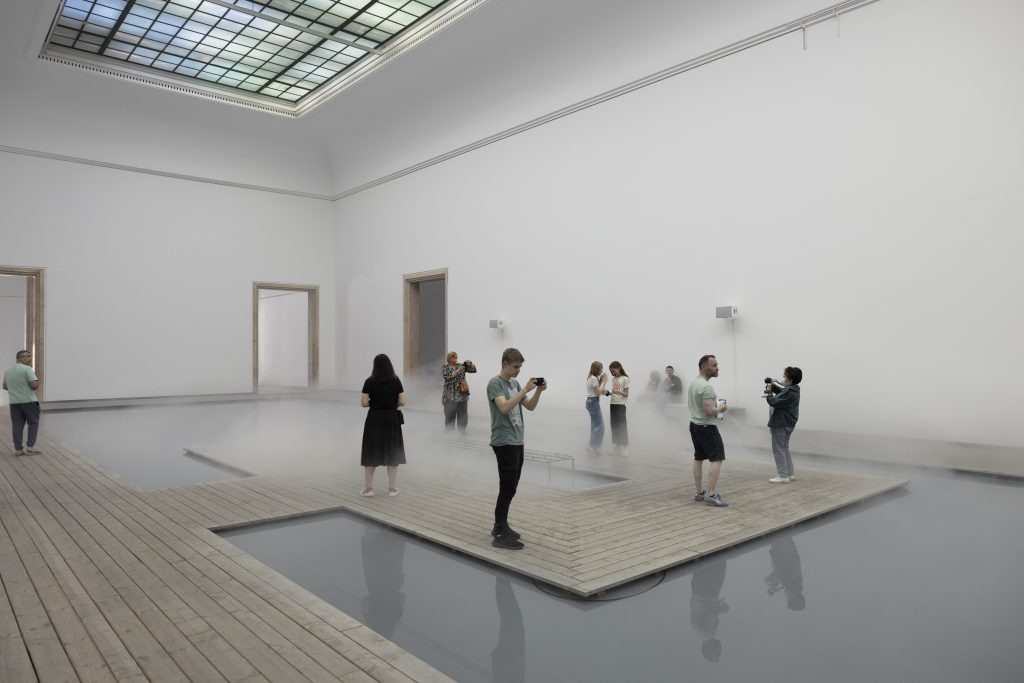
THE ENVIRONMENTAL DOMAIN
Treating snow crystals as “letters from heaven” constitutes a profoundly respectful attitude towards the study of nature. It turns the work of natural science into a hermeneutic activity, always interpreting some greater meaning in these tiny objects. Ukichiro Nakaya’s concern for being attentive to nature seems to have extended beyond his work on snow crystals as well. Late in his life, his collaborations with American researchers in Greenland led him to express concern over rising levels of CO2 in the atmosphere, and the warming effect this produced. His close involvement with the cryosphere—those parts of the globe that are frozen—made him particularly sensitive to the relationship between ice and us. Whether it be on a small scale, like how body heat accelerates the melting of a snowflake, or on a large scale, like how anthropogenic CO2 emissions accelerate the melting of ice caps, engagement with the cryosphere demands an awareness of humanity’s destructive influences.
Fog, on the other hand, has ambiguous environmental connotations. Visually, it connects all sorts of phenomena that put human and non-human life in danger, bearing resemblance to the carpet of smoke over a burning forest, the condensation trails of a passing airliner, the mists of toxic pesticides sprayed over industrial farmland, or the haze of smog (literally “smoke” and “fog”) over a polluted city. Culturally, fog has been used to evoke the dread of the unknown and lurking danger: think of Stephen King’s The Mist (1980), or literally any horror movie. Additionally, Charles Dickens’ conjuring of an oppressive London fog in his novels arguably defined the popular image of the toxic city in the mid-19th century. Such examples show how many in the West have been conditioned to see fog as something ominous, a symptom of something bad (there is, after all, no smoke without fire).
Yet we find fog irresistible. Whilst writing this piece I went for a run in Munich’s English Garden on a cool late-afternoon, and a thick fog appeared above the Schwabinger Bach that flows through its southern half. The fog seemed to have a magnetic power, as people from all sides of the park converged on it. Observing from afar I could see dozens of human-like silhouettes roaming within. It seemed to have a calming effect, providing serenity in an otherwise busy environment. It narrows our perspective to that which is right in front of us. Of course, part of the fascination I witnessed from passers-by stems from the novelty factor: such a thick and localised fog is rare enough for people to take notice, especially since it may soon be gone again. But perhaps this unpredictable and fleeting nature of fog is also what makes it valuable to us. Modern economies and societies have been built on the assumption that the Earth is a repository of resources, available to exploit at our will. This exploitative attitude has put at risk the future of all living things on the planet. What if we were to live with the Earth on its own terms? Artists like Fujiko Nakaya that “collaborate” with the air and the landscape seem to be on the right track. You cannot own a bit of fog, nor can you extract and displace it. It cannot be hoarded by collectors, or profited from by investors. You experience it in the moment when it’s there. You can try to manoeuvre it, but ultimately it will choose its own path. Some technical infrastructure is required to run it, but science and technology alone are not inherently harmful to nature. Foggy wake in a desert #94925 (1982), an installation designed by Nakaya for the Australian National Gallery in Canberra, has had the effect of revitalising the arid landscape, “thickening the foliage and cultivating a range of species”, demonstrating the positive ecological impact her work can have. Ultimately, it isn’t science and technology that threaten the environment, but how we choose to use them.
Fog and Snow Crystals: Watery Boundary Objects
These days, environmental activists and scientists alike are looking for the most effective ways to inform the public about the dangers of climate change, biodiversity loss, and other environmental disasters. Many look towards science communication as a tool to inform people about these issues, and get them to rethink their relationships with the natural environment. Others see in environmentalist art and design opportunities to confront and motivate people into taking informed and active stances on these issues. Deep-seeded assumptions (at least in Western thought) about the way science is done and art is made means we often see them as separate means to separate ends. Many, of course, look to combine scientific and artistic ways of thinking and doing, pursuing art-informed science or science-informed art projects. But implicit in such framings is this idea of there being a separation between the two, of having to make the conscious step of bridging a gap and justifying doing so. The Nakayas, on the other hand, offer an encouraging example of a kind of work that speaks to scientific, artistic, and environmental discussions seemingly effortlessly. None of these three domains is somehow considered secondary or separate from the other two. I may have referred to the father as a scientist and the daughter as an artist, but to cling to these labels is to neglect the many-sidedness of their respective works. Much of this many-sidedness is made possible by the artefacts they worked with: snow crystals and fog. In both cases, these objects were used in seemingly contrasting ways, blending artifice and nature, rationality and the unknown, revelation and obscurity. As natural phenomena, they evoke wonder and admiration. As boundary objects, they appeal to a diverse set of actors. If there is one thing the Nakayas have shown over the past 90 years, it is the value of putting wonder-inducing boundary objects at the centre of one’s scientific, artistic, or environmental practice, and creating a space for these different domains to dissolve into one another.
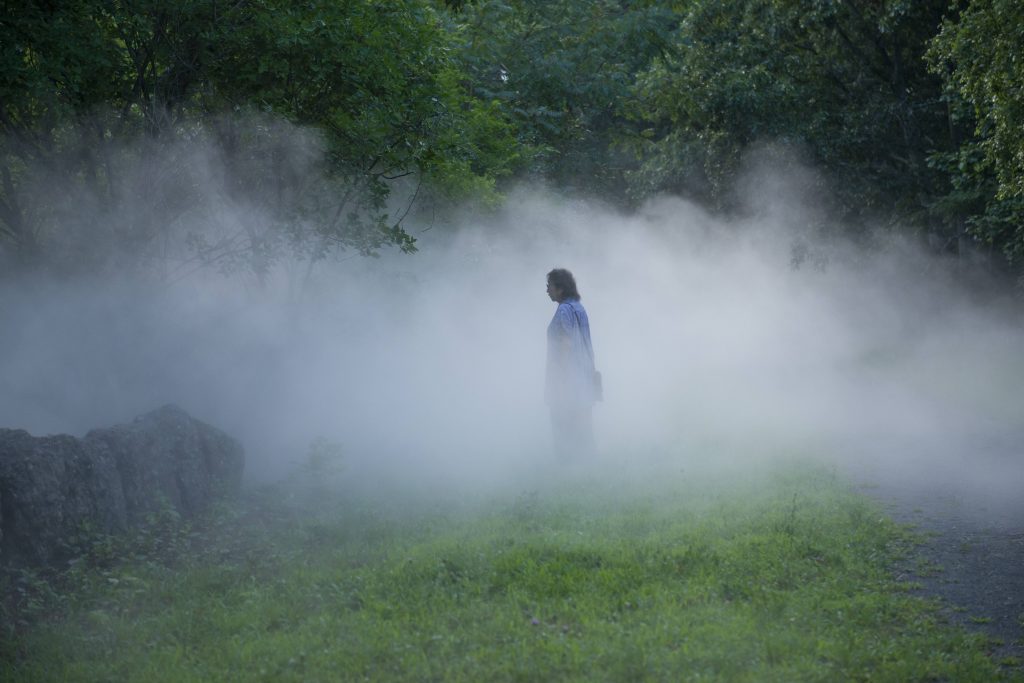
All photography: Exhibition views of FUJIKO NAKAYA. NEBEL LEBEN
Haus der Kunst, Munich, Germany, 2022
This is an excerpt from an article published in the first issue of hube magazine. For the full experience, you can buy a copy here.
